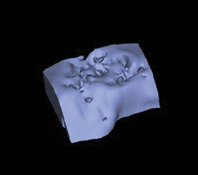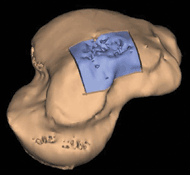Mixed results seen in using fresh osteochondral talar allograft for large talar lesions
Surgical options for treating large osteochondral lesions of the talus have included various cartilage stimulating procedures, fusion or arthroplasty. Recent research has found another option: fresh osteochondral allograft from a suitable cadaveric donor which offers the advantage of transplanting living cartilage that is biologically attached to the subchondral bone.
However, the study also found that even though a patient’s functional outcome can be substantially improved with this experimental technique, early radiographic finds are not so encouraging, with more than 50% of patients demonstrating progression of arthritis and 70% showing signs of osteolysis or cyst formation. Furthermore, nearly 20% of patients required secondary arthroscopic debridement and about 25% of cases were deemed outright failures.
Promising technique
Despite these shortcomings, the partial ankle transplant “purports to preserve the majority of the patient’s own ankle joint, while replacing the damaged part with living tissue,” said lead investigator Roger A. Haene, MD, FRCS(Tr&Orth), a clinical fellow in orthopedics at Ipswich Hospital in Suffolk, United Kingdom, who at the time of the study was a clinical fellow for the primary author Tim Daniels, MD, FRCSC, at St. Michael’s Hospital in Toronto, Ontario, Canada. “This technique holds a lot of promise, in being able to hopefully restore the ankle to normality, which is far better than a replacement, for instance, because the transplanted living tissue is self-healing.”
The 15-patient study included eight men and seven women with an overall mean age of 35.8 years, was presented at the 2010 American Orthopaedic Foot and Ankle Society (AOFAS) Summer Meeting in National Harbor, Md. The investigators had a mean clinical follow-up of 4 years, a mean X-ray follow-up of 3.7 years, and a mean CT follow-up of 4 years. During this time period, the AOFAS score, the Ankle Osteoarthritis Score (AOS) for pain and disability, the American Academy of Orthopaedic Surgeons (AAOS) foot and ankle score all improved significantly.
Contrasting data
“None of the patients had a reduction in their function or worsening of their pain scores, and most were improved,” Haene said. “There were also no rejections of the allograft.”
In contrast, neither the AAOS foot and ankle score nor the Mental Component Summary scores of the SF-36 showed significant improvement.
At an average 4 years postoperative, 23.5% of ankles were functioning well and 35.3% had mild to moderate ongoing symptoms.
The fresh osteochondral allograft of matching size “has to be harvested within 24 hours of death of the donor and cannot be used more than 14 days after harvesting because at that point the cartilage cells are not longer in a position to support the cartilage matrix production,” Haene told Orthopedics Today. The allograft also needs to be stored below 4° C, but not below freezing.
|
|
|
|
|
This 3D reconstruction from a CT scan shows the allograft (left), the excised defect (center), and the talus following transplant (right). Images: Cadden A |
||
Immobilization
The postoperative nonweight-bearing period with this novel surgery ranges from 6 to 12 weeks. “However, patients move their ankle very shortly after surgery,” Haene said. “It is also a single operation which restores motion, improves pain and allows large defects to be filled, whereas the standard of care [fusion] can involve several procedures — if the fusion is unsuccessful, which can happen in high-risk populations.” Additionally, fusion sometimes requires bone grafts, “frequently taken from the patient himself, for multiple sites of surgery,” Haene said. “This increases the pain and complication rate.”
Fusion patients may also suffer from being held immobile in a cast for a long period. “Hence, they can lose the function of the foot. In time, a stiff fused ankle will promote the development of arthritis of the adjacent joints,” Haene said.
Despite the benefits of a fresh osteochondral allograft, “this procedure must be reserved for salvage of cases that have failed arthroscopic debridement or osteochondral autograft transfer system [OATS] or autologous chondrocyte implantation [ACI] because of the rates of subsequent arthroscopy or outright failure in some patients,” Haene cautioned. – by Bob Kronemyer
Reference:Haene R, Daniels TR, Story R, et al. Intermediate clinical and CT outcome of fresh osteochondral allografts to the ankle. Presented at the American Orthopaedic Foot and Ankle Society Annual Summer Meeting. July 7-10. National Harbor, Md.
Roger A. Haene, MD, FRCS(Tr&Orth) can be reached at Department of Orthopedics, Ipswich Hospital, Heath Road, Ipswich IP4 5PD, United Kingdom; 44 1473 71 22 33; e-mail: roger@haene.org.
![]() Follow
OrthoSuperSite.com on Twitter
Follow
OrthoSuperSite.com on Twitter



